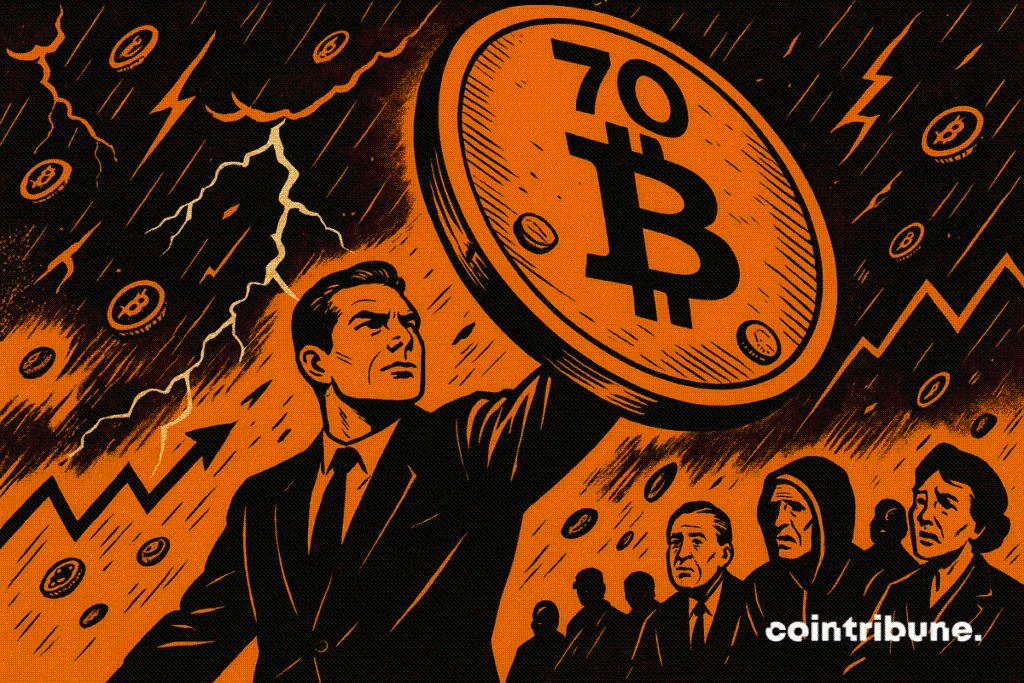Strategy unveils a new anti-panic weapon against the bitcoin crisis
Since the fall of bitcoin, Strategy’s strategy worries more than one. Faced with this, the company has just unveiled a new tool. A move to reassure crypto investors and maintain its role as an institutional pillar. More details in the following paragraphs!

In brief
- Strategy launches a BTC Rating to reassure markets after the marked bitcoin drop.
- The company claims 70 years of financial margin, even if the bitcoin price remains stagnant.
Strategy counter-attacks with a BTC Rating
The BTC Rating is an indicator expressly designed by Strategy. It is supposed to reflect the company’s debt strength following the recent market turbulence on bitcoin.
More explicitly, the BTC Rating relies on the notional value of preferred shares. It shows that even if bitcoin falls to $74,000 (its average purchase price), Strategy retains an asset/debt ratio of 5.9. If the price collapses to $25,000, the ratio will remain at 2.
In both cases, the liquidity would allow dividends to be paid for 70 years. A projection that some consider ambitious but credible in a flat market scenario.
This communication aims to dispel the fear of a domino effect on the stocks of companies related to digital assets, often called DAT (Digital Asset Treasuries). The BTC Credit Dashboard published by Strategy centralizes these key data.
Debt, dividends and mNAV: the new equation of bitcoin strategy’s strength
Alongside this BTC Rating , another indicator attracts attention: the mNAV (Market Net Asset Value). This index compares the enterprise value to that of crypto holdings (notably bitcoin).
With a score of 1.16, Strategy can theoretically still raise funds by issuing shares. A capacity no longer available to some struggling players like Bitmine and Sharplink Gaming.
Some analysts confirm this strength. According to them, the dividend strategy holds up long-term (unless there is a sudden regulatory change). For others, Strategy’s continuous accumulation of bitcoin could slow future drops by absorbing part of the supply. These reserves, considered “off-market,” thus block an additional selling pressure.
While the crypto market remains volatile, the signals sent by Strategy thus reinforce its position as an institutional bastion for bitcoin. The company becomes a reference to follow in the assessment of crypto risks.
Disclaimer: The content of this article solely reflects the author's opinion and does not represent the platform in any capacity. This article is not intended to serve as a reference for making investment decisions.
You may also like
Ethereum Updates: Ethereum Drops to $2,800, Prompting Surge in Demand for ZKP's Hardware-Based Presale
- Ethereum's price fell below $2,800, triggering $6.5M liquidations and testing critical support levels amid declining on-chain demand metrics. - Institutional players like BitMine accumulated 3.62M ETH (~$10.4B) despite the selloff, signaling long-term bullish conviction. - ZKP's hardware-driven presale gained traction with $17M in ready-to-ship Proof Pods and Miami Dolphins partnership for privacy-focused sports analytics. - Mutuum Finance's $19M DeFi presale and ZKP's auction model with $50K wallet caps

Vitalik Buterin Supports ZKsync: What This Means for Layer 2 Scaling
- Vitalik Buterin endorsed ZKsync in late 2025, highlighting its "underrated and valuable" work alongside the Atlas upgrade achieving 15,000 TPS and $0.0001 fees. - ZKsync's zero-knowledge rollups and EVM compatibility enabled institutional adoption by Deutsche Bank , Sony , and Goldman Sachs for cross-chain and enterprise use cases. - The Fusaka upgrade aims to double throughput to 30,000 TPS by December 2025, positioning ZKsync to compete with Polygon zkEVM and StarkNet in Ethereum's Layer 2 landscape. -

The ZK Atlas Enhancement: Revolutionizing Blockchain Scalability?
- ZKsync's 2025 Atlas Upgrade achieves 15,000–43,000 TPS with sub-1-second finality, addressing Ethereum L2 scalability bottlenecks via Airbender proofs and modular OS. - DeFi protocols like Aave and Lido leverage ZKsync's $0.0001/tx costs to unify liquidity, while Deutsche Bank and Sony adopt its trustless cross-chain infrastructure for compliance and transparency. - ZK token surged 150% post-upgrade, with TVL hitting $3.3B and analysts projecting 60.7% CAGR for ZK Layer-2 solutions by 2031 amid instituti

XRP News Update: XRP ETFs Spark Optimism—Is $1,115 Within Reach?
- XRP's price surge to $2.20 is driven by ETF launches, with $422M inflows from Franklin Templeton and Grayscale. - Technical indicators suggest a potential $2.50+ rally if support at $1.84 holds, with long-term forecasts reaching $26.50 by 2030. - Institutional adoption of Ripple's ODL and Ripple USD's $1B+ market cap highlight growing utility beyond remittances. - Regulatory clarity post-SEC ruling and macroeconomic factors remain critical for XRP's $1,115 potential in ultra-bullish scenarios.

